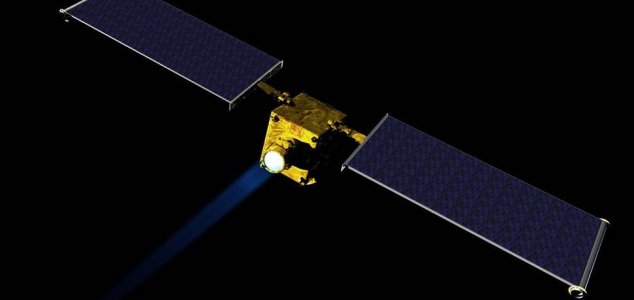Space & Astronomy
July 2, 2017 · 8 comments
8 comments

An artist's impression of what DART will look like. Image Credit: NASA / JHUAPL
While still in the preliminary design phase, the goal of the mission will be to strike Didymos B - the smaller of two binary asteroids that will approach the Earth in 2022 and then again in 2024.
"A binary asteroid is the perfect natural laboratory for this test," said program scientist Tom Statler.
"The fact that Didymos B is in orbit around Didymos A makes it easier to see the results of the impact, and ensures that the experiment doesn't change the orbit of the pair around the sun."
At around the size of a fridge, DART would use its on-board autonomous targeting system to aim directly at Didymos B before striking it at a speed nine times faster than that of a bullet.
"DART is a critical step in demonstrating we can protect our planet from a future asteroid impact," said Andy Cheng of The Johns Hopkins Applied Physics Laboratory in Laurel, Maryland.
"Since we don't know that much about their internal structure or composition, we need to perform this experiment on a real asteroid."
"With DART, we can show how to protect Earth from an asteroid strike with a kinetic impactor by knocking the hazardous object into a different flight path that would not threaten the planet."
Source: NASA.gov | Comments (8)
NASA to launch asteroid deflection mission
By T.K. RandallJuly 2, 2017 ·
 8 comments
8 comments
An artist's impression of what DART will look like. Image Credit: NASA / JHUAPL
For the first time ever, an asteroid deflection technique for planetary defense is set to be tested out.
Known as DART ( Double Asteroid Redirection Test ), the mission will demonstrate how a potentially deadly asteroid impact can be averted by striking the object with enough force to shift its trajectory away from the Earth - a method known as the kinetic impactor technique.While still in the preliminary design phase, the goal of the mission will be to strike Didymos B - the smaller of two binary asteroids that will approach the Earth in 2022 and then again in 2024.
"A binary asteroid is the perfect natural laboratory for this test," said program scientist Tom Statler.
"The fact that Didymos B is in orbit around Didymos A makes it easier to see the results of the impact, and ensures that the experiment doesn't change the orbit of the pair around the sun."
"DART is a critical step in demonstrating we can protect our planet from a future asteroid impact," said Andy Cheng of The Johns Hopkins Applied Physics Laboratory in Laurel, Maryland.
"Since we don't know that much about their internal structure or composition, we need to perform this experiment on a real asteroid."
"With DART, we can show how to protect Earth from an asteroid strike with a kinetic impactor by knocking the hazardous object into a different flight path that would not threaten the planet."
Source: NASA.gov | Comments (8)

The Unexplained Mysteries
Book of Weird News
AVAILABLE NOW
Take a walk on the weird side with this compilation of some of the weirdest stories ever to grace the pages of a newspaper.
Click here to learn more

Support us on Patreon
BONUS CONTENTFor less than the cost of a cup of coffee, you can gain access to a wide range of exclusive perks including our popular 'Lost Ghost Stories' series.
Click here to learn more
Israel, Palestine and the Middle-East
United States and the Americas
Ancient Mysteries and Alternative History
Earth, Natural Disasters and the Environment
Total Posts: 7,768,037 Topics: 325,015 Members: 203,759
Not a member yet ? Click here to join - registration is free and only takes a moment!
Not a member yet ? Click here to join - registration is free and only takes a moment!

































Please Login or Register to post a comment.